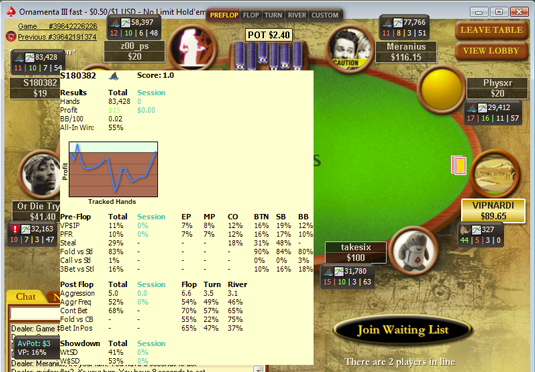Member Comments
Guestirord's Comment
2017-11-17 23:02:45guest test post [url=http://gdhyuei23kol.com/]bbcode[/url] html http://gdhyuei23kol.com/ simple
 One of the most important things to know about your opponent is how aggressive he or she tends to be. While there are a number of ways to assess this, the two most common are Aggression Factor and Aggression Frequency. While the two stats are often confused, they are quite different and each has its own spot.
One of the most important things to know about your opponent is how aggressive he or she tends to be. While there are a number of ways to assess this, the two most common are Aggression Factor and Aggression Frequency. While the two stats are often confused, they are quite different and each has its own spot.
Knowing your opponent's aggression level doesn't just give you information about what their bet or raise means; it also helps you understand their level of poker experience and education. Passive players are easy to beat, but education usually helps a player get their aggression levels up quickly. Even intermediate players in today's tough online games are much more aggressive than they were just a few years ago.
Let's take a look at each stat.
Aggression Factor (AF) is the number of times a player bets and raises divided by the number of times they call. This does not deal with how often a player checks and referring to it as aggression is a bit of a misnomer. AF actually refers to how often a player calls, but a player who folds too much, almost never calls, and only raises with a huge hand would have a very high aggression factor. This player might check and fold most of the time, but they would appear to be aggressive if AF were your metric. AF still has some use, but most people who have it in their HUD are just using it because they started using it years ago before Aggression Frequency was available and haven't changed over.
Correct numbers for AF depend on the game, but most Hold’em players who consistently win are above 2 and many of the best players are above 3. A player with an AF below 2 is very easy to deal with. When they start betting and raising, you can get out of the way; they probably have a strong hand and will often give you free cards and allow you to determine how big the pot will be. This is why my advice to beginners about how to beat home games usually starts with "raise or fold" and ends with "don't be a calling station."
Aggression Frequency (AFq or AF%) is calculated by adding bets and raises together and dividing that number by raises + bets + calls + folds. While the formula sounds complicated, you'll find that it's a simple statistic and you don't need to remember how it's calculated to make use of it. I have AFq in all of my cash game HUDs and AF has been retired. You can also simplify this formula by seeing it as bet % + raise % and it may make more sense. The goal of AFq is to define how often a player shows aggression when it’s their turn to act.
Most winning players will have an AFq between 28% and 41%. Anything below 28% can still represent a winning player, but they are much easier to deal with and less likely to bluff or be bluffed. A player higher than 43% is really pushing it and you may be able to make a nice profit by checking to them and letting them hang themselves because they can be counted on to bet frequently if they see a chance to steal the pot. Be cautious if a player with a high AFq checks to you; he may be planning a check-raise.
Street Aggression
Many cash game players have AFq for each street in their HUDs. This helps them understand how their opponent's behavior changes as the hand progresses. Solid players are typically more aggressive early in the hand and the least aggressive on the river, while a weak player may be duped into betting every time they miss and will often just want to see the next card cheaply until the river.
VP and Aggression
The best players don't just look at an individual stat to help them make a decision; they look at all of the stats to get a picture of their opponent. We first saw this in our discussion of PFR and VP and how they must be considered together. The relationship between AFq and VP is very important. A loose player with an AFq of 35% is much more aggressive than a tight player with a similar AFq. This is because the loose player is being aggressive with a much wider range of hands while the tight player's tighter range means that he may not be all that aggressive.
This means that player with a VP of 28 and an AFq of 40% is being very aggressive with a wide range of hands. It shouldn't be tough to beat this player by checking to him, calling his bets when you have a strong hand, and making big check-raises with your draws if his WSD number is above 50%.
On the other hand, a player with a VP of 16 and an AFq of 40% is betting with a much tighter range and you'll need a stronger hand to call him down. Depending on his WSD numbers, you may be able to bluff him off some of his hands, but it's better not to mess with this player unless you have the goods because he will usually have a real hand.
Check out our analyses of Pre-Flop Raise and Voluntarily Put Money into the Pot to learn more.
guest test post [url=http://gdhyuei23kol.com/]bbcode[/url] html http://gdhyuei23kol.com/ simple